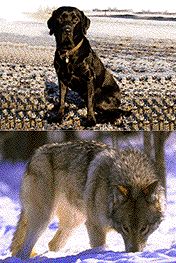Classification and evolution - What are the two principles used to classify species?

The phylogenetic principle of classification is evolutionary.
Only entities that have evolutionary relations can be classified in this way. In contrast to the phenetic principle, it classifies species according to how recently they share a common ancestor. Two species that share a more recent common ancestor will be put in a group at a lower level than two species sharing a more distant common ancestor.
For instance the wolf and the dog opposite share a more recent common ancestor than do a wolf and a dolphin: they are therefore both classified in the genus Canis.
As the common ancestor of two species becomes more and more distant, they are grouped further and further apart in the classification. In the end, all species are contained in the category of the set of all living things which contains all the descendants of the most distant common ancestor of life.
The phylogenetic principle is the basis behind the taxonomic school called cladism.
The biologist Mike Donaghue explains the reasoning behind the phylogenetic principle.
| Next |



